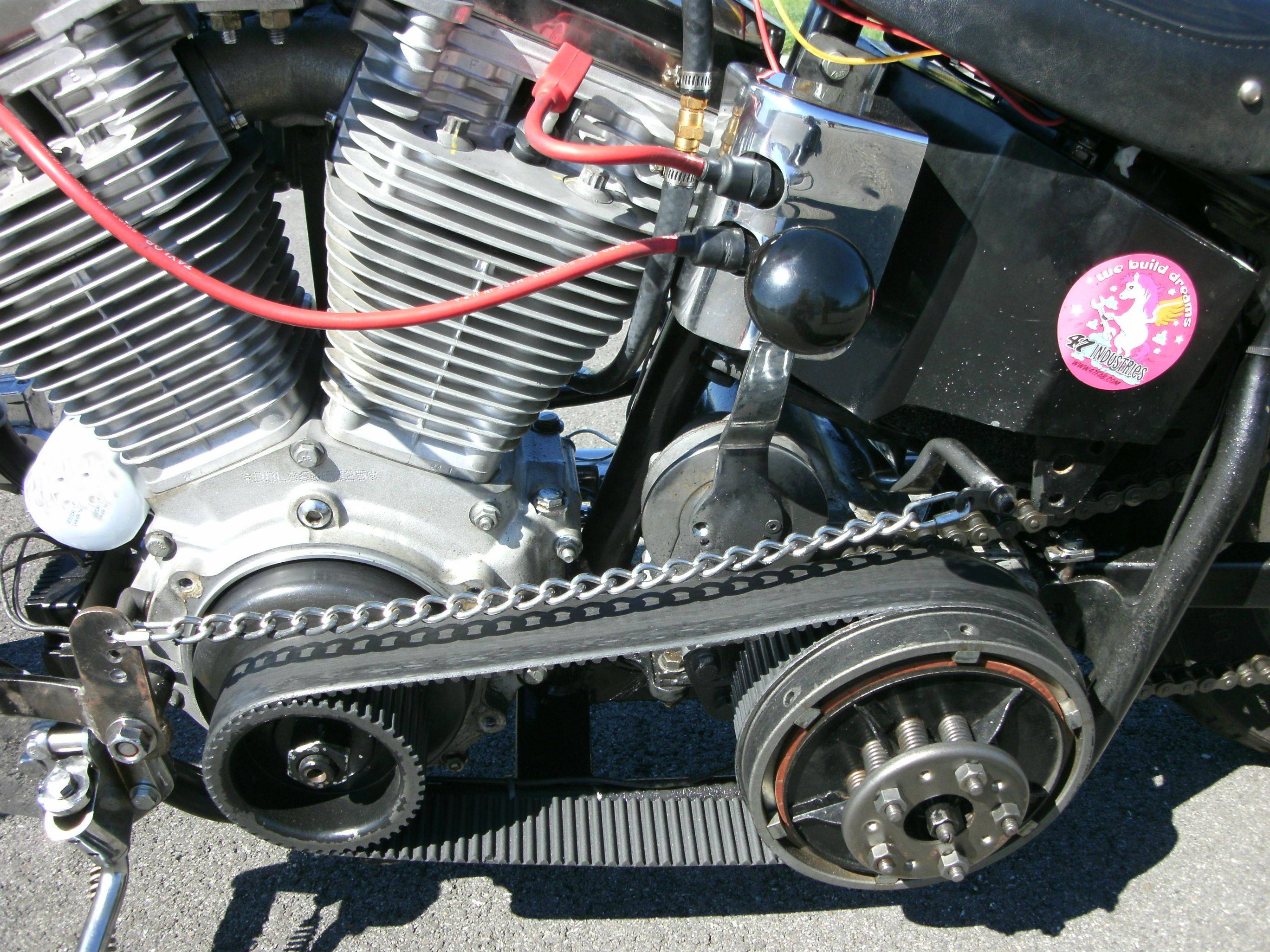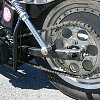Have you ever seen a dude ripping down the tarmac, hand behind his butt while he works a jockey shifter, wondering how in the Sam Hill he isn’t losing fingers to the belt or chain whirling around inches from his fingertips? Did you ever wonder why that drivetrain is hanging out there in the breeze for everyone to see?
Everywhere you look, choppers seem to have converted drive trains. Chains, belts and clutches hanging out — it’s a mess. Good gravy, why do folks change them up? These kids and their cut-up scooters, I tell you.
Sounds like a topic for our next episode of Why things are the way they are.

Let’s start with some Harley-Davidson history. For years and years, Harleys were equipped with a chain primary and a chain final drive. The primary chain had engine oil dripped onto it from two places: a dedicated oiler, and the separate breather hose that shed oily mist onto the primary chain. The primaries had a small hole in them for the oil to leak out of when parked or riding. (Surprise, surprise — bet you didn’t know that many Harleys were designed to leak, did you?)
The final drive chain was cared for as you’d expect, with periodic maintenance that required cleaning and lubricating.
That was fine up until the days of the Shovelhead. In the interest of not makin’ a friggin’ mess, the hole in the primary was eliminated, and the oil that dripped onto the chain was sucked back into the system, to be filtered and re-used. In the 80s, Harley began equipping bikes with final drive belts as opposed to chains. The belts were quieter and required less maintenance. On some models, like the Sturgis FXSB, they even used a dual-belt setup (belt primary, belt final). They were doing all sorts of weird stuff. Heck, some Touring bikes and FXRs even had enclosed final drive chains! The whole shootin’ match back there sat encased in its own oil bath! (This prolonged the life quite a bit, but it made changing a chain a real hassle!) H-D was still trying to figure out how to efficiently move power through the drivetrain without making messes, environmental nightmares, or dirty, angry riders.
Eventually, with the dawn of the Evo engine. H-D settled on the system still in use today: a primary drive chain enclosed in its own housing with separate, un-shared oil that requires the occasional change, and a belt final drive. The system has many advantages. The oil can help to cool the stator and clutch plates, and its isolation from the engine makes its design superior even to its Japanese brethren. Dirty, clutch-impregnated oil never makes its way into the engine, and a chain running in an oil bath, sealed from outside dirt and debris, runs very cool and wears slowly. The drive belt is a pretty low-maintenance item, considering the great mileage it’s capable of racking up before needing attention.
So why do all these guys running around on Pans and Shovels seem to go flipsy-daisy and use a primary drive belt and a final drive chain?
Let’s start with the rear. A chain final drive has many advantages that are particularly interesting to chopper dudes. For starts, you can change the ratio much easier with a chain. If you get a larger or smaller sprocket, making the chain fit is as easy as cutting to the correct length. Since many chopper guys are building monster motors and using primaries and transmissions with unknown gearsets, sometimes the easiest way to change your final gear ratio is simply to slap a new sprocket on the beast and roll on.

That same ease of changing also helps on the road. I’ve carried a 530 master link on my key chain since my salad days, and it’s gotten me out of East Jabip (Kalamzaoo, BFE… you know where I mean) more than once. Changing a belt on the side of the road is nigh on impossible. One must remove the rear wheel, swingarm, inner and outer primary — you may as well try to perform brain surgery out there. I’m sure one or two souls have gotten the job done, but a chain repair is far easier than a belt repair.
Remember those hotrod engines we were talking about? Those are hard on belts. Also hard on belts are hot-dog riding and wheelies. I’ve never met a dude who built a gnarly scoot who didn’t like to twist her wick from time to time. Belts, especially long ones, tend to be less forgiving of shock load being applied and removed than their chain contemporaries. So that answers the first half of the question. Chopper dudes usually move away from belt final drives for ease of repair and parts swapping, longer life, and better power distribution.
Now, let’s go to the primary. That sealed chain sounded pretty good, right? It does, except to some chopper folk. Choppers are supposed to be simple and stripped-down. They’re supposed to be easy to work on. If you’re wrenching, you ain’t drinking. H-D’s need clutches adjusted regularly, and primary chains need to be adjusted, as well. Rather than getting all greasy, one can simply pop off the inner and outer primary, replace the chain and sprockets with a belt-drive unit, and away we go. Belt primaries also offer the benefit of one less fluid leaking on the ground. Even greasy chopper weirdoes grow tired of leaks. Finally, the belt in the primary position is much less of a hassle than the final drive because it is the outermost belt in the system. Those of you who have ever had to change an automotive belt that is closest to the block will appreciate that point.
If ultimate simplicity is desired, heck, don’t even put a primary or cover back on. Just run the belt open. I once changed a clutch on the side of the road with simply a 9/16-inch wrench, a large washer, and a screwdriver. A belt in the primary position is not hard to deal with because you don’t have to remove much, if anything, to get to it. And I believe that takes care of the second part of the question. Chopper guys like belt primaries because they are durable and reliable, and they make servicing and repairing the motorcycle much easier.
Also, belts just look badass spinning away, and we like hearing our loud, ancient, dry clutches. A clacky clutch is a functioning one, most of the time!
Meanwhile, final drive chains are what all the old bikes had. No one ever longs for an old Knuckle and wants a drive belt on it. Chopper dudes like stuff to be easy and not break down — not too far off from non-chopper riders, eh?
So the next time you see a bike that came out of the factory with a chain primary drive and belt final drive, and got a belt primary and chain final when it was chopped, now you know why things are the way they are.







